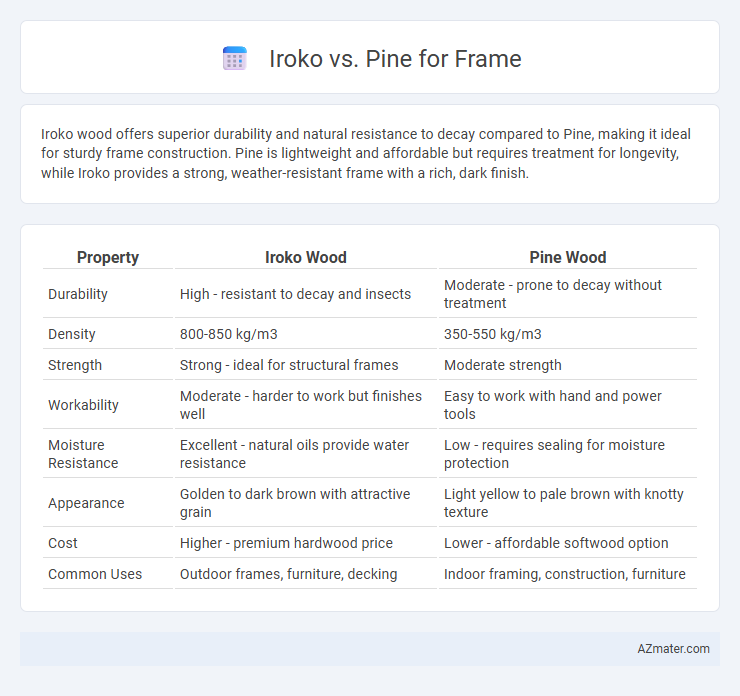Iroko wood offers superior durability and natural resistance to decay compared to Pine, making it ideal for sturdy frame construction. Pine is lightweight and affordable but requires treatment for longevity, while Iroko provides a strong, weather-resistant frame with a rich, dark finish.
Table of Comparison
| Property | Iroko Wood | Pine Wood |
|---|---|---|
| Durability | High - resistant to decay and insects | Moderate - prone to decay without treatment |
| Density | 800-850 kg/m3 | 350-550 kg/m3 |
| Strength | Strong - ideal for structural frames | Moderate strength |
| Workability | Moderate - harder to work but finishes well | Easy to work with hand and power tools |
| Moisture Resistance | Excellent - natural oils provide water resistance | Low - requires sealing for moisture protection |
| Appearance | Golden to dark brown with attractive grain | Light yellow to pale brown with knotty texture |
| Cost | Higher - premium hardwood price | Lower - affordable softwood option |
| Common Uses | Outdoor frames, furniture, decking | Indoor framing, construction, furniture |
Introduction to Iroko and Pine Wood
Iroko wood, known for its durability and resistance to decay, is a tropical hardwood commonly used in outdoor furniture and construction, prized for its rich golden to dark brown color and dense grain. Pine wood, a softwood sourced predominantly from the Northern Hemisphere, is valued for its lightweight properties, ease of workability, and pale yellow to white color with distinctive knots. Choosing between Iroko and Pine for frames depends on factors like strength requirements, weather resistance, and aesthetic preferences, with Iroko offering superior longevity and Pine providing cost-effectiveness and versatility.
Origins and Botanical Differences
Iroko (Milicia excelsa) is a hardwood native to tropical Africa, known for its dense, durable timber, while Pine (genus Pinus) comprises coniferous softwoods primarily found in the Northern Hemisphere. Iroko's botanical classification places it in the Moraceae family, characterized by broad leaves and a slow growth rate, contrasting with Pine species in the Pinaceae family that display needle-like leaves and faster growth cycles. The wood anatomy differs significantly, with Iroko's interlocked grain providing high resistance to decay, whereas Pine's softer, resinous wood is more susceptible to environmental wear but easier to work with in construction.
Durability and Lifespan Comparison
Iroko offers superior durability compared to pine, as it is a dense hardwood resistant to rot, insects, and weathering, making it ideal for long-lasting frames. Pine, a softwood, is more prone to dents, scratches, and decay, often requiring treatment to improve its lifespan and durability. Iroko frames typically last 25-40 years outdoors, whereas untreated pine frames may only endure 5-10 years under similar conditions.
Strength and Structural Performance
Iroko wood exhibits superior strength and structural performance compared to pine due to its higher density and hardness, making it ideal for heavy-duty frames requiring durability and resistance to wear. Pine, being a softer and lighter wood, is easier to work with but offers less load-bearing capacity and is more prone to dents and deformation over time. The natural resistance of Iroko to moisture and decay further enhances its stability and longevity in structural applications.
Aesthetic Qualities: Color and Grain
Iroko wood offers a rich golden to medium brown color that deepens with age, providing a warm and luxurious aesthetic ideal for premium frames. Its coarse, interlocking grain pattern creates an attractive texture with natural variations that enhance visual interest. Pine presents a lighter, creamy yellow hue with a straight, uniform grain that evokes a simple, rustic charm suitable for casual or country-style frames.
Workability and Ease of Machining
Iroko wood offers excellent workability with its medium to coarse texture and interlocking grain, making it less prone to tearing when planed or machined compared to pine. Pine, being a softwood, is easier to cut and shape by hand or machine but tends to produce more splintering and dents during machining processes. The density of iroko provides superior stability and strength for frames, while pine's softness allows for quicker, smoother shaping but requires careful handling to avoid damage.
Weather Resistance and Maintenance Needs
Iroko wood offers superior weather resistance compared to pine, boasting natural oils that repel moisture and resist rot, making it ideal for outdoor frames exposed to harsh conditions. Pine, while more affordable and lightweight, requires regular sealing and treatment to prevent weather damage and decay. Maintenance for iroko is minimal due to its durability, whereas pine demands frequent upkeep to maintain its integrity and appearance over time.
Environmental Impact and Sustainability
Iroko wood, harvested from African tropical forests, is often considered more sustainable than pine due to its natural durability, reducing the need for chemical treatments that harm the environment. Pine, a fast-growing softwood commonly sourced from plantations, offers quicker renewability but typically requires preservatives and frequent replacements, increasing its ecological footprint. Choosing Iroko for framing supports longer-lasting structures with less environmental degradation, while pine's rapid growth can benefit reforestation efforts if sourced responsibly.
Cost Analysis: Iroko vs Pine
Iroko wood generally commands a higher price compared to pine due to its durability and resistance to decay, making it a costlier choice for frames. Pine is more affordable and widely available, ideal for budget-conscious projects but may incur higher maintenance costs over time. Evaluating the total lifecycle cost reveals that Iroko's longevity can offset its initial expense, while pine frames might require more frequent replacements or treatments.
Best Applications for Iroko and Pine Frames
Iroko wood is best suited for outdoor furniture and window frames due to its high durability, natural resistance to rot and insects, and excellent weathering properties. Pine frames are ideal for indoor applications like picture frames or furniture, offering easy workability, affordability, and a smooth finish that takes paint or stain well. Choosing Iroko ensures longevity in harsh environments, while pine provides a lightweight and cost-effective option for decorative or interior framing projects.

Infographic: Iroko vs Pine for Frame
 azmater.com
azmater.com